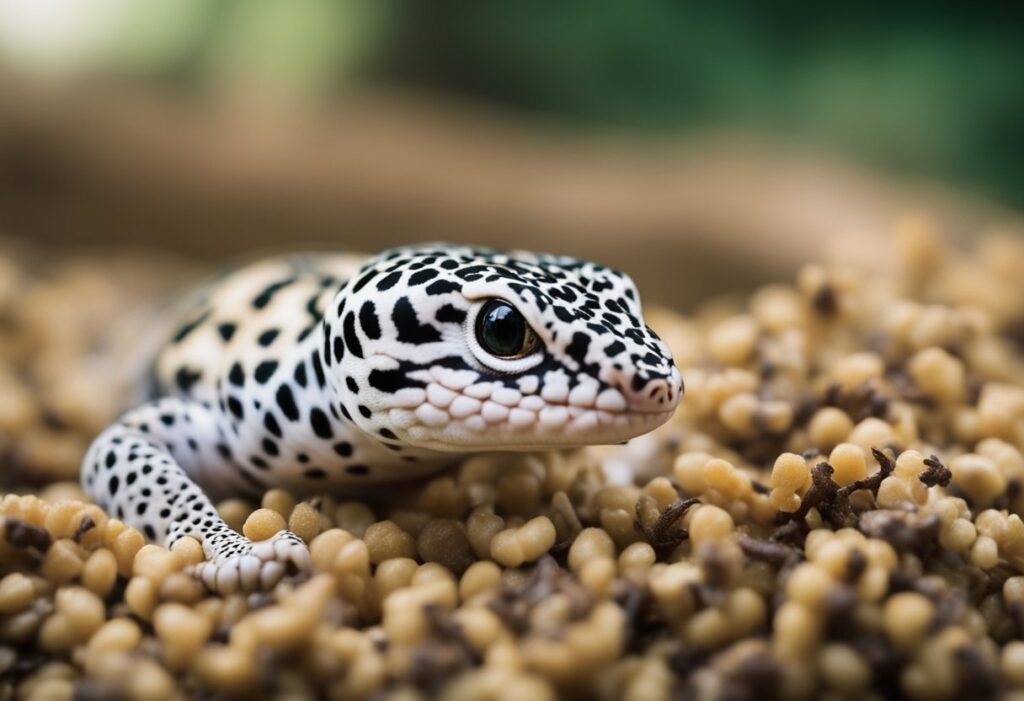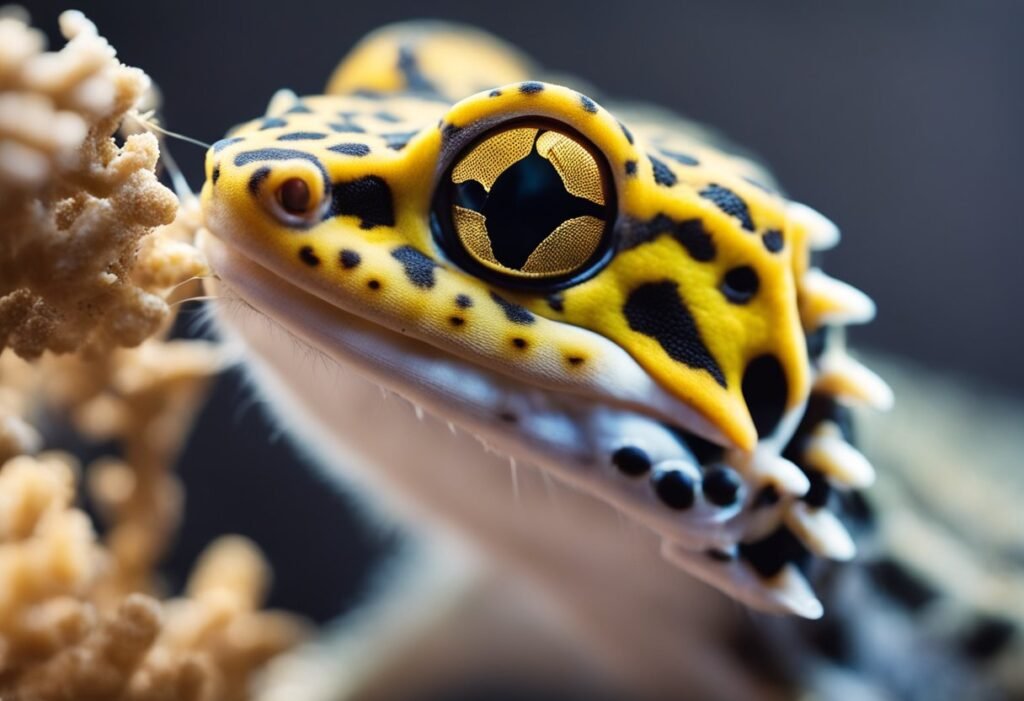Leopard geckos are popular pets among reptile enthusiasts due to their docile nature and low maintenance. As with any pet, it is important to provide them with a well-balanced diet to ensure their health and longevity. One common question among leopard gecko owners is whether or not they can eat superworms.
Superworms are a popular feeder insect for many reptiles due to their high protein content and ease of care. However, it is important to note that leopard geckos have specific dietary requirements and not all insects are suitable for their consumption. In this article, we will explore whether or not leopard geckos can eat superworms and the potential benefits and drawbacks of including them in their diet.
Dietary Basics for Leopard Geckos

When it comes to feeding leopard geckos, it’s important to remember that they are insectivores. In the wild, they primarily eat insects such as crickets, mealworms, and waxworms. However, it’s important to provide them with a varied diet to ensure they receive all the nutrients they need to stay healthy.
One thing to keep in mind is that leopard geckos have different nutritional requirements at different stages of their lives. For example, juvenile geckos require more protein than adult geckos. As a general rule, we recommend feeding juvenile leopard geckos every day, while adult geckos can be fed every other day.
It’s also important to make sure that any insects you feed your leopard gecko are appropriately sized. Insects that are too large can cause impaction, which can be fatal. As a general rule, the insects you feed your gecko should be no larger than the space between their eyes.
When it comes to feeding leopard geckos superworms, it’s important to keep in mind that they are high in fat. While they can be a good source of protein, they should be fed in moderation. We recommend feeding superworms as a treat rather than a staple of your gecko’s diet.
Overall, a varied diet that includes a mix of insects is the best way to ensure your leopard gecko receives all the nutrients they need to stay healthy. By following these dietary basics, you can help ensure your gecko lives a long and healthy life.
Understanding Superworms as Food

Superworms are a popular feeder insect for leopard geckos due to their high protein content and availability. However, it is important to understand the nutritional value of superworms and how they fit into a leopard gecko’s diet.
Superworms are high in fat and protein, making them a good source of nutrition for leopard geckos. However, they should not be the sole source of food for your gecko. It is recommended to feed a variety of insects to ensure a balanced diet.
When feeding superworms, it is important to consider their size. Superworms can grow up to 2 inches long, which may be too large for smaller leopard geckos. It is recommended to feed superworms that are no larger than the width of your gecko’s head.
Additionally, it is important to gut-load superworms before feeding them to your leopard gecko. Gut-loading involves feeding the insects a nutritious diet before feeding them to your gecko. This ensures that your gecko is receiving the maximum nutritional value from the insects.
In conclusion, superworms can be a nutritious addition to a leopard gecko’s diet when fed in moderation and in combination with other feeder insects. It is important to consider the size of the superworms and to gut-load them before feeding them to your gecko.
Health Benefits of Superworms for Leopard Geckos

Superworms are a great source of nutrition for leopard geckos. They contain a variety of nutrients that are essential for the health and wellbeing of these reptiles. Here are some of the health benefits of feeding superworms to leopard geckos:
- High in Protein: Superworms are an excellent source of protein, which is important for the growth and development of leopard geckos. Protein is also essential for maintaining healthy skin, muscles, and organs.
- Rich in Fat: While too much fat can be unhealthy for leopard geckos, a moderate amount of fat is necessary for their overall health. Superworms contain a good balance of fat and protein, making them a nutritious food source for these reptiles.
- Contains Vitamins and Minerals: Superworms are rich in vitamins and minerals that are important for leopard geckos. They contain calcium, which is essential for strong bones and teeth, as well as other important nutrients like vitamin A and vitamin D.
- Easy to Digest: Superworms are easy for leopard geckos to digest, which is important for their overall health. They have a soft exoskeleton that is easy to break down, making them a great food source for young and adult leopard geckos alike.
Overall, superworms are a nutritious and healthy food source for leopard geckos. They provide a variety of essential nutrients that are important for their growth and development, and are easy for them to digest. As with any food source, it is important to feed superworms in moderation and as part of a balanced diet.
Risks and Precautions When Feeding Superworms
When feeding leopard geckos superworms, it is important to be aware of the risks and take necessary precautions to ensure the safety and health of your pet.
Firstly, superworms have a hard exoskeleton that can be difficult for leopard geckos to digest. This can lead to impaction, a potentially life-threatening condition where the digestive tract becomes blocked. To prevent this, we recommend feeding superworms in moderation and only to geckos that are at least six months old and over six inches in length.
Additionally, superworms are high in fat and low in calcium, which can lead to obesity and calcium deficiency in leopard geckos. To avoid these issues, we suggest dusting superworms with a calcium supplement before feeding and alternating them with other feeder insects that are higher in calcium, such as crickets and mealworms.
Another potential risk when feeding superworms is their ability to bite and injure leopard geckos. To minimize this risk, we recommend removing any uneaten superworms from the enclosure after 15-20 minutes and keeping them in a separate container with food and water until the next feeding.
In conclusion, while superworms can be a nutritious and tasty addition to a leopard gecko’s diet, it is important to take precautions and be aware of the potential risks. By following these guidelines, we can ensure the health and well-being of our beloved pets.
How to Feed Superworms to Leopard Geckos

Leopard geckos are known to be voracious eaters, and superworms are a great addition to their diet. However, it is important to know how to feed them properly to ensure their health and well-being. Here are some tips on how to feed superworms to leopard geckos.
Preparing Superworms
Before feeding superworms to your leopard gecko, it is important to prepare them properly. Here are some steps to follow:
- Store the superworms in a container with a lid that has small holes for ventilation.
- Keep the container at room temperature, between 70-80°F, and away from direct sunlight.
- Feed the superworms a nutritious diet, such as carrots or commercial cricket food, at least 24 hours before feeding them to your leopard gecko.
- Remove any dead or damaged superworms before feeding them to your leopard gecko.
Feeding Frequency and Quantity
Leopard geckos should be fed superworms in moderation. Here are some guidelines to follow:
- Feed your leopard gecko 2-3 superworms per feeding, depending on the size of the gecko.
- Feed your leopard gecko every other day, or 2-3 times a week.
- Avoid overfeeding your leopard gecko, as this can lead to obesity and other health issues.
In conclusion, superworms can be a great addition to your leopard gecko’s diet when fed properly. By following these tips, you can ensure that your leopard gecko stays healthy and happy.
Alternatives to Superworms in Leopard Gecko Diet
While superworms are a popular choice for feeding leopard geckos, there are other options that can provide similar nutritional value. Here are some alternatives to consider:
Mealworms
Mealworms are a common staple in leopard gecko diets. They are easy to find and provide a good source of protein. However, they are not as fatty as superworms, so it’s important to supplement with other foods to ensure a balanced diet.
Crickets
Crickets are another popular choice for feeding leopard geckos. They are high in protein and can be found in most pet stores. However, they can be noisy and difficult to handle. Additionally, they can carry parasites, so it’s important to purchase from a reputable source.
Dubia Roaches
Dubia roaches are a nutritious and easy-to-digest option for leopard geckos. They are high in protein and fat, making them a good choice for growing geckos. They are also low-maintenance and easy to keep.
Waxworms
Waxworms are a tasty treat for leopard geckos, but should be fed sparingly due to their high fat content. They are a good source of calcium, which is important for maintaining healthy bones.
Overall, there are many options when it comes to feeding leopard geckos. It’s important to provide a varied diet that includes a mix of protein sources, vegetables, and supplements to ensure a healthy and happy gecko.
Monitoring Your Leopard Gecko’s Health
As responsible pet owners, it is our duty to ensure that our leopard geckos are healthy and happy. One way to do this is by monitoring their health regularly. Here are some tips on how to do so:
Physical Examination
Performing a physical examination on your leopard gecko is a great way to check for any signs of illness or injury. Some things to look out for include:
- Abnormalities in the skin, such as cuts or bumps
- Discoloration or discharge from the eyes, nose, or mouth
- Swelling or tenderness in the limbs or abdomen
- Abnormalities in the feces, such as diarrhea or blood
If you notice any of these symptoms, it is best to consult with a veterinarian who specializes in reptiles.
Weight Monitoring
Leopard geckos can sometimes suffer from obesity or malnourishment. To prevent this, it is important to monitor their weight regularly. You can do this by weighing them on a scale and keeping track of their weight over time. A healthy leopard gecko should weigh between 45-80 grams, depending on their age and gender.
Feeding Habits
Another way to monitor your leopard gecko’s health is by observing their feeding habits. Leopard geckos are known to be voracious eaters, so a sudden loss of appetite could be a sign of illness. On the other hand, overeating can lead to obesity and other health problems. It is important to feed your leopard gecko a balanced diet of live insects, such as crickets and superworms, and vegetables.
By following these tips, you can ensure that your leopard gecko stays healthy and happy. Remember to always consult with a veterinarian if you notice any signs of illness or injury.
Frequently Asked Questions

What are the best dietary options for leopard geckos?
Leopard geckos are insectivores and require a diet high in protein. Some of the best dietary options for leopard geckos include crickets, mealworms, and dubia roaches. It is important to feed them a variety of insects to ensure they receive all the necessary nutrients.
Is it safe for juvenile leopard geckos to consume superworms?
Superworms can be too large for juvenile leopard geckos and may cause impaction if not properly digested. It is recommended to wait until they are at least 6-8 months old before offering superworms as part of their diet.
What types of vegetables are appropriate for leopard geckos to eat?
Leopard geckos are not big vegetable eaters, but some safe options include carrots, squash, and leafy greens. Vegetables should be offered sparingly as they do not provide the necessary nutrients that insects do.
Are there any fruits that are suitable for leopard geckos to include in their diet?
Fruits should also be offered sparingly, but some safe options include mango, papaya, and figs. It is important to remove any seeds or pits before feeding to prevent choking.
How should superworms be prepared and offered to leopard geckos?
Superworms should be gut-loaded with nutritious food and dusted with calcium powder before being offered to leopard geckos. They can be offered live or dead, but it is recommended to offer them dead to prevent them from burrowing into the substrate.
What are some other insects that leopard geckos can safely eat?
Leopard geckos can also safely eat waxworms, silkworms, and phoenix worms. It is important to research and ensure any new insects being offered are safe and nutritious for leopard geckos.





